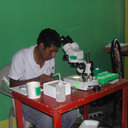Epidemics of dengue, chikungunya and Zika are a growing threat to areas where Aedes aegypti are present. The efficacy of chemical control of Ae. aegypti is threatened by the increasing frequency of insecticide resistance. The objective of this study was to determine the susceptibility status as well as the biochemical and molecular mechanisms underlying insecticide resistance in three populations of Ae. aegypti in high risk areas of dengue, chikungunya, and Zika in Peru.Bioassays were conducted on adult Ae. aegypti to evaluate their susceptibility to insecticides used currently or historically for mosquito control in Peru, including six pyrethroids, three organophosphates and one organochlorine, in populations of Ae. aegypti from the districts of Chosica (Department of Lima), Punchana (Department of Loreto) and Piura (Department of Piura). Resistance mechanisms were determined by biochemical assays to assess activity levels of key detoxification enzyme groups (nonspecific esterases, multi-function oxidases, glutathione S-transferases and insensitive acetylcholinesterase). Real-time PCR assays were used to detect two kdr mutations (V1016I and F1534C) on the voltage-gated sodium channel gene.Resistance to DDT was detected in all three populations, and resistance to pyrethroids was detected in all populations except the population from Chosica, which still exhibited susceptibility to deltamethrin. Resistance to organophosphates was also detected, with the exception of populations from Punchana and Piura, which still demonstrated susceptibility to malathion. In general, no increase or alteration of activity of any enzyme group was detected. Both 1016I and 1534C alleles were detected in Punchana and Piura, while only the 1534C allele was detected in Chosica.The results suggest that resistance to multiple classes of insecticides exist in areas important to Ae. aegypti-borne disease transmission in Peru. The F1534C mutation was present in all 3 populations and the V1016I mutation was present in 2 populations. To our knowledge, this is the first report of the presence of 1016I and 1534C in Ae. aegypti in Peru. The absence of highly elevated enzymatic activity suggests that target site resistance is a key mechanism underlying insecticide resistance in these populations, although further research is needed to fully understand the role of metabolic resistance mechanisms in these populations.


